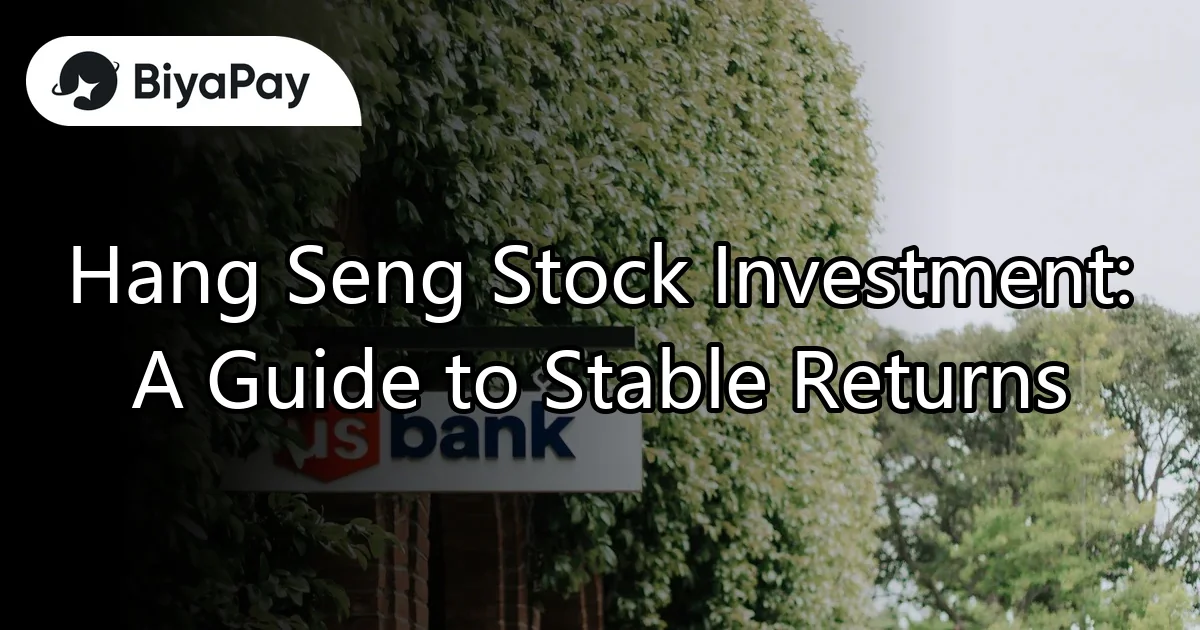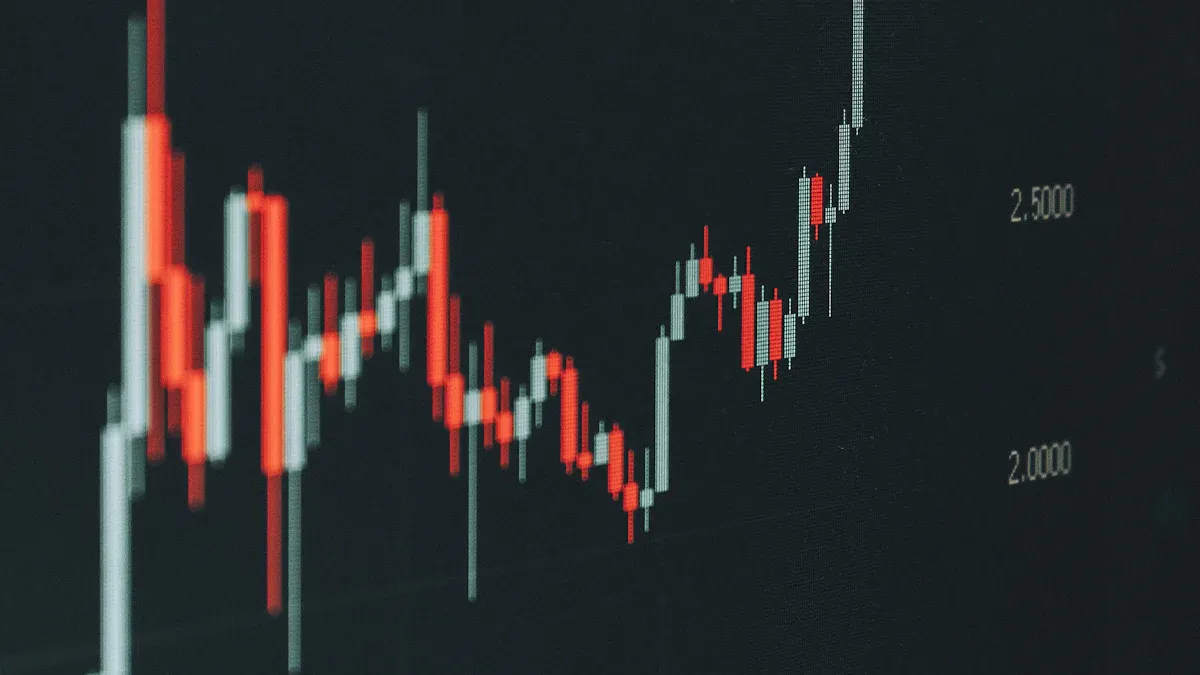- EasyCard
- Trade
- Help
- Announcement
- Academy
- SWIFT Code
- Iban Number
- Referral
- Customer Service
- Blog
- Creator
Hang Seng Stock Investment: A Guide to Stable Returns

Image Source: pexels
The Hang Seng High Dividend Yield ETF is a tool designed for investors seeking stable returns. It primarily tracks the Hang Seng China High Dividend Yield Index, which has a dividend yield of up to 9.18%. This means you can enjoy stable dividend returns through long-term holding. The ETF’s constituent stocks are concentrated in the financial, real estate, and energy sectors, which typically perform well during economic recoveries, further enhancing investment stability.Additionally, income-generating stocks offer defensive capabilities during market volatility, allowing you to achieve relatively stable returns in unstable market environments. Choosing the Hang Seng High Dividend Yield ETF is equivalent to mastering an investment approach that diversifies risk and provides stable returns, and the performance of these investments is also influenced by the Hang Seng stock price.
Key Points
- The Hang Seng High Dividend Yield ETF offers a dividend yield of up to 9.18%, suitable for investors seeking stable returns.
- Investing in this ETF effectively diversifies risk, as its constituent stocks span the financial, real estate, and energy sectors, reducing the impact of volatility in a single sector.
- Long-term holding of the Hang Seng High Dividend Yield ETF can reduce transaction costs, focus on stable returns, and avoid frequent trading due to short-term fluctuations.
- Regularly review your investment portfolio and consider diversifying into ETFs from other sectors or regions to further reduce risk.
- Opening a securities account and selecting an appropriate trading platform is the first step in investing, with consideration of transaction fees and user experience.
What is the Hang Seng High Dividend Yield ETF?

Image Source: unsplash
Basic Concept of ETFs
An ETF, or Exchange-Traded Fund, is a collective investment vehicle. It combines multiple stocks or assets and is listed on an exchange, allowing you to trade it like a regular stock. The biggest feature of ETFs is their high transparency, low fees, and ability to effectively diversify investment risk. When you invest in an ETF, you not only gain exposure to shares of multiple companies but also enjoy their dividend returns. This makes ETFs an ideal choice for both beginner and experienced investors.
How the Hang Seng High Dividend Yield ETF Works
The Hang Seng High Dividend Yield ETF focuses on tracking the Hang Seng China High Dividend Yield Index. This index includes companies with high dividend yields, primarily concentrated in the financial, real estate, and energy sectors. When you purchase this ETF, your funds are diversified across the index’s constituent stocks. These companies typically have stable profitability and pay dividends regularly. The ETF’s management company adjusts the holdings based on the index’s performance, ensuring your investment closely follows the index’s trends. This operating mechanism allows you to easily participate in multiple companies and enjoy stable dividend returns.
Relationship Between Hang Seng Stock Price and High Dividend Yield ETF
Fluctuations in the Hang Seng stock price directly affect the performance of the Hang Seng High Dividend Yield ETF. When the Hang Seng stock price rises, the ETF’s value typically increases as well, offering opportunities for capital appreciation. Conversely, when the Hang Seng stock price falls, the ETF’s value may be affected. However, since the constituent stocks of the high-dividend ETF are mostly companies with stable dividends, you can still receive steady dividend returns even during stock price fluctuations. This characteristic makes the Hang Seng High Dividend Yield ETF a resilient investment tool against market volatility, particularly suitable for investors seeking long-term returns.
Advantages and Risks of Investing in the Hang Seng High Dividend Yield ETF
Source of Stable Returns
The stable returns of the Hang Seng High Dividend Yield ETF primarily come from the high dividend yields of its constituent stocks. These companies typically have stable profitability and pay dividends regularly. For example, the Hang Seng China High Dividend Yield Index has a dividend yield of up to 9.18%, far exceeding the market average. This means you can receive regular dividend returns by holding the ETF without worrying about the performance of individual companies. The financial, real estate, and energy sectors are the main constituent stocks of the index, and these sectors typically perform well during economic recoveries, further enhancing the stability of returns.
Benefits of Risk Diversification
Investing in the Hang Seng High Dividend Yield ETF effectively diversifies risk. The ETF spreads funds across multiple companies, avoiding the impact of poor performance by a single stock on your portfolio. For example, the constituent stocks of the Hang Seng High Dividend Yield ETF cover the financial, real estate, and energy sectors, which typically do not move in complete sync. When one sector faces challenges, other sectors may remain stable, thereby reducing portfolio volatility. Here are some key metrics of the ETF:
| Metric | Value |
|---|---|
| Index Dividend Yield | 9.18% |
| Main Constituent Stock Categories | Financial, Real Estate, Energy |
| Regulatory Policy | Three Red Lines Policy |
| Price-to-Book Ratio | Fell below 1 for the first time |
These data demonstrate that the ETF’s constituent stocks have stability and risk resistance, allowing you to invest with greater peace of mind.
Potential Risks and Mitigation Strategies
While the Hang Seng High Dividend Yield ETF offers stable returns and risk diversification, it still carries some potential risks. First, fluctuations in the Hang Seng stock price may affect the ETF’s value. When the Hang Seng stock price falls, the ETF’s opportunities for capital appreciation may decrease. Second, changes in regulatory policies, such as the Three Red Lines Policy, may impact the real estate sector’s performance, thereby affecting the ETF’s returns.
To address these risks, you can adopt the following strategies:
- Regular Portfolio Review: Closely monitor the Hang Seng stock price and the performance of constituent stocks, adjusting your investment strategy in a timely manner.
- Diversified Investment: In addition to the Hang Seng High Dividend Yield ETF, consider investing in ETFs from other sectors or regions to further reduce risk.
- Long-Term Holding: Focus on long-term returns and avoid frequent trading due to short-term fluctuations.
Through these strategies, you can better manage risks and achieve stable investment returns.
How to Start Investing in the Hang Seng High Dividend Yield ETF?
Opening a Securities Account
To start investing in the Hang Seng High Dividend Yield ETF, the first step is to open a securities account. You need to choose a reliable securities firm, which typically offers a variety of investment products, including ETFs. The account opening process usually involves the following steps:
- Prepare Identification Documents: Such as a Hong Kong ID card or passport.
- Complete the Application Form: Provide personal information and contact details.
- Submit Financial Information: Some securities firms may require proof of income or asset status.
- Complete Identity Verification: Some firms may require in-person or online verification.
When choosing a securities firm, consider its transaction fees, service quality, and platform stability. For example, major Hong Kong securities firms like Phillip Securities and Bright Smart Securities offer stable trading services and diverse investment options.
Choosing a Trading Platform
Selecting an appropriate trading platform is a crucial step for successful investing. Different platforms vary in fees, service levels, and user experience. Here is a data table comparing trading performance across different time frames to help you understand the impact of market volatility on trading:
| Time Frame | Average Maximum Gain | Average Closing Gain |
|---|---|---|
| 1 Minute | N/A | 1.11% |
| 3 Minutes | N/A | 1.05% |
| 5 Minutes | N/A | 1.07% |
| 4 Hours | 3.73% | -1.29% |
| 8 Hours | 5.84% | -1.36% |
| 24 Hours | 9.5% | -3.34% |
Additionally, the following chart illustrates the comparison trend between closing and maximum average gains across different time frames, helping you more intuitively understand market volatility:
When choosing a trading platform, consider the following factors:
- Transaction Fees: Such as commissions per trade and platform usage fees.
- User Experience: Whether the platform is easy to operate and provides real-time market data.
- Service Support: Whether 24-hour customer service and technical support are available.
For example, platforms like Futu Securities and Interactive Brokers offer low fees and efficient trading experiences, suitable for both beginners and experienced investors.
Order Placement Process and Considerations
After opening an account and selecting a platform, you can start placing orders to purchase the Hang Seng High Dividend Yield ETF. Here is the basic order placement process:
- Log into the Trading Platform: Use your account credentials to log in.
- Search for the ETF Code: The Hang Seng High Dividend Yield ETF’s code is typically “3085” or another designated code.
- Select the Transaction Type: Such as a market order or limit order.
- Enter the Transaction Quantity: Input the number of units to purchase based on your investment plan.
- Confirm the Transaction: Verify all details and submit the order.
When placing orders, pay attention to the following considerations:
- Market Volatility: Fluctuations in the Hang Seng stock price may affect the ETF’s price, so choose an appropriate trading timing.
- Transaction Costs: Be aware of the platform’s commissions and other hidden fees.
- Fund Management: Avoid investing too much at once; consider buying in batches to reduce risk.
Through these steps, you can easily start investing in the Hang Seng High Dividend Yield ETF and enjoy stable dividend returns.
Practical Investment Strategies

Image Source: unsplash
Dollar-Cost Averaging
Dollar-cost averaging is a simple and effective strategy, particularly suitable for investors with limited funds. This method allows you to purchase the Hang Seng High Dividend Yield ETF with a fixed amount at regular intervals. Regardless of whether the market price is high or low, you can continuously accumulate investment positions and benefit from the cost-averaging effect.
For example, Mr. Li used dollar-cost averaging to invest in high-quality stocks, and even during market volatility, his portfolio maintained stable growth, proving the long-term effectiveness of this strategy. Additionally, data shows that dollar-cost averaging has lower volatility, reducing market impact and making it suitable for investors seeking stable returns.
Here is the historical performance data for dollar-cost averaging:
| Starting Rise/Fall Point | Total Return | Annualized Return |
|---|---|---|
| 2010/6/1 (Starting Rise) | 137.7% | 10.6% |
| 2007/10/1 (Starting Fall 1) | 153.4% | 10.4% |
| 2018/10/1 (Starting Fall 2) | 31.9% | 10.8% |
These data show that regardless of whether the market is at a high or low point, dollar-cost averaging can provide stable returns.
Diversification Strategy
Diversification is an effective method for reducing risk. By spreading funds across different asset classes or sectors, you can reduce the impact of volatility in a single market on your portfolio. For example, the constituent stocks of the Hang Seng High Dividend Yield ETF cover the financial, real estate, and energy sectors, which typically do not move in complete sync, further reducing risk.
Statistical data shows that a mixed stock-bond portfolio generally offers higher risk-adjusted returns than a pure stock portfolio. Here is the correlation data for different asset classes:
| Asset Class | 1-Year Correlation | 3-Year Correlation |
|---|---|---|
| U.S. Long-Term Treasury Bonds vs. U.S. Stocks | -0.49 | -0.391 |
This indicates that diversification can effectively reduce risk, especially during periods of high market volatility. As the investment period extends, returns generally increase, further demonstrating the effectiveness of diversification.
Long-Term Holding Mindset
Long-term holding is a strategy focused on stable returns. When you choose to hold the Hang Seng High Dividend Yield ETF long-term, you can avoid frequent trading due to short-term market fluctuations, thereby reducing transaction costs and psychological stress.
Low-volatility strategies can reduce losses during market turmoil, highlighting the advantages of long-term holding. Although investment performance may vary depending on entry timing, long-term investing can smooth out market volatility and provide stable returns.
Tip: Past performance is not a guarantee of future results, but long-term holding helps you focus on long-term goals rather than short-term fluctuations.
By regularly reviewing your portfolio and maintaining patience, you can achieve stable investment returns over the long term.
The Hang Seng High Dividend Yield ETF is a stable income investment choice, suitable for those seeking long-term returns. It provides stable dividend returns and effectively diversifies risk. You need to understand its advantages and potential risks and choose an investment strategy that suits you, such as dollar-cost averaging or diversification. Focus on long-term holding and avoid frequent trading due to short-term fluctuations. Stable returns and patience are the keys to success. Through continuous learning and portfolio reviews, you can move closer to your financial goals.
FAQ
1. How much capital is needed to invest in the Hang Seng High Dividend Yield ETF?
The investment amount depends on the ETF’s unit price and the quantity you purchase. For example, if the ETF’s unit price is 10 USD, purchasing 100 units requires 1,000 USD. Additionally, consider the trading platform’s commissions and other fees.
2. Who is the Hang Seng High Dividend Yield ETF suitable for?
This ETF is suitable for investors seeking stable income and long-term returns. If you want to diversify risk and achieve stable dividend returns, this is an ideal choice. Both beginners and experienced investors can consider it.
3. How to choose an appropriate trading platform?
When choosing a platform, consider the following factors:
- Transaction Fees: Such as commissions and hidden fees.
- User Experience: Whether the platform is easy to operate.
- Service Support: Whether 24-hour technical support is available.
For example, Futu Securities and Interactive Brokers are common choices.
4. How are dividends from the Hang Seng High Dividend Yield ETF distributed?
The ETF’s dividends are typically distributed quarterly or semi-annually to your securities account. The distribution timing and amount are determined by the ETF’s management company, with specific details available in the fund’s prospectus.
5. Are there risks in investing in the Hang Seng High Dividend Yield ETF?
All investments carry risks. The risks of the Hang Seng High Dividend Yield ETF include fluctuations in the Hang Seng stock price and changes in regulatory policies. It’s recommended to regularly review your portfolio and adopt diversification strategies to reduce risk.
Tip: Understanding risks and developing mitigation strategies can help improve investment success rates.
In 2025, the Hang Seng High Dividend Yield ETF offers a 9.18% dividend yield for steady returns, helping you diversify risk, but Hang Seng price volatility, regulatory changes, and trading platform commissions can raise costs—how can you achieve global asset allocation at low cost? BiyaPay provides an all-in-one financial platform, enabling seamless trading of Hong Kong and US stocks without offshore accounts, allowing flexible investing and further risk diversification.
Supporting USD, HKD, and 30+ fiat and digital currencies, real-time exchange rate tracking ensures cost transparency, while global remittances to 190+ countries feature transfer fees as low as 0.5%, far below traditional bank and platform charges, with swift delivery for digital finance needs. A 5.48% annualized yield savings product, with no lock-in period, balances return stability with liquidity. Sign up for BiyaPay today to combine the ETF’s reliable dividends with BiyaPay’s global financial solutions, creating an efficient, low-cost wealth management experience!
*This article is provided for general information purposes and does not constitute legal, tax or other professional advice from BiyaPay or its subsidiaries and its affiliates, and it is not intended as a substitute for obtaining advice from a financial advisor or any other professional.
We make no representations, warranties or warranties, express or implied, as to the accuracy, completeness or timeliness of the contents of this publication.




Contact Us
Company and Team
BiyaPay Products
Customer Services
is a broker-dealer registered with the U.S. Securities and Exchange Commission (SEC) (No.: 802-127417), member of the Financial Industry Regulatory Authority (FINRA) (CRD: 325027), member of the Securities Investor Protection Corporation (SIPC), and regulated by FINRA and SEC.
registered with the US Financial Crimes Enforcement Network (FinCEN), as a Money Services Business (MSB), registration number: 31000218637349, and regulated by FinCEN.
registered as Financial Service Provider (FSP number: FSP1007221) in New Zealand, and is a member of the Financial Dispute Resolution Scheme, a New Zealand independent dispute resolution service provider.



















